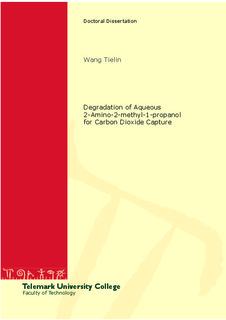| dc.contributor.author | Wang, Tielin | |
| dc.date.accessioned | 2013-03-01T10:57:21Z | |
| dc.date.accessioned | 2017-04-19T12:11:02Z | |
| dc.date.available | 2013-03-01T10:57:21Z | |
| dc.date.available | 2017-04-19T12:11:02Z | |
| dc.date.issued | 2013-01-29 | |
| dc.identifier.citation | Wang, T. Degradation of Aqueous 2-Amino-2-methyl-1-propanol for Carbon Dioxide Capture. Doctoral dissertation, Telemark University College, 2013 | |
| dc.identifier.isbn | 978-82-7206-365-7 | |
| dc.identifier.issn | 1893-3068 | |
| dc.identifier.uri | http://hdl.handle.net/11250/2437799 | |
| dc.description | Papers I-IV (p. 176-210) not available in TEORA due to publisher restrictions | |
| dc.description.abstract | Absorption-stripping with aqueous 2-amino-2-methyl-1-propanol (AMP), and especially AMP blends with other amines, such as monoethanolamine (MEA) and piperazine (PZ), presents an attractive option for carbon dioxide (CO2) capture from flue gas in coal-fired power plants. Alkanolamine based solvents degrade in this service. The purpose of this work was to investigate AMP solvent degradation under thermal and oxidizing conditions, to measure rates of degradation for comparison with other solvents, to identify the degradation products and to identify possible degradation pathways. 5 mol/kg AMP without CO2 loading was thermally stable up to 140°C under a blanket gas of N2, exhibiting very low loss rates. However, with an initial CO2 loading of 0.15 and 0.3mol CO2/mol AMP at 135°C, AMP lost 3.8(mol)% and 5.5 (mol)% after 5 weeks, respectively. The steric hindrance in AMP molecule slows down CO2 induced degradation of AMP as compared to MEA, but it does not prevent oxazolidinone formation and oxazolidinone ring-opening into further degradation products. The rate of oxidative degradation of AMP was investigated over a range of temperature, CO2 loading, and AMP concentration. At 100 to 140 °C, degradation was found to be O2 mass transfer limited in the employed batch reactors, however, the degradation rate increased with CO2 loading. No significant effect of pH value was observed on the AMP degradation rate. Acetone, 2,4-lutidine, 4,4-dimethyl-2-oxazolidinone and formate were the main identified degradation products. Oxidative degradation of AMP likely proceeds through a Habstraction step followed by production of a peroxyl radical. The peroxyl radical is proposed to decompose to primary products by intramolecular H-abstraction via a six-membered cyclic transition sate. The reactions of AMP and the primary degradation products lead to the final degradation products. Acetone oxime and 4,4-dimethyl-1,3-oxazolidine were minor products at 100-140°C, but they were major products at 80°C. Temperature significantly affects the distribution of the ultimate degradation products. UV radiation with a medium mercury lamp can dramatically accelerate the oxidation of AMP at 55°C. It seems that UV radiation does not change the primary degradation mechanism of AMP. The degradation products of UV accelerated oxidation are different from those of thermally accelerated oxidation of AMP, probably due to the impact of temperature on the secondary reactions of the primary products. AMP oxidation is proposed to be initiated by a radical mechanism, but the reaction is not a chain reaction. The degradation rate of 1.5 mol/kg PZ is 1.2 mmol/(kg·h) within 19 days, which is approximate half of that of 5 mol/kg AMP under 250 kPa O2 and at 100°C. A possible degradation pathway of PZ is proposed based on the identified products. The degradation rate of AMP in AMP/PZ blends is close to that in a single AMP system, however, PZ degraded faster in the blends than it degraded individually at identical degradation conditions. As compared to degradation of single MEA and AMP solvents, no new product was found in the degraded AMP/MEA mixture without CO2 loading. Increasing the initial MEA concentration in the mixture, the amount of AMP loss decreased indicating that MEA protects AMP from oxidation. This inhibition effect of MEA on AMP degradation could be due to the fact that MEA degrades faster than AMP in the blends. | |
| dc.language.iso | eng | |
| dc.publisher | Telemark University College | |
| dc.relation.ispartofseries | Doctoral dissertations at TUC;2013:1 | |
| dc.relation.haspart | Paper I: Wang, T. & Jens, K.-J. (2012). Oxidative Degradation of Aqueous 2-Amino-2- methyl-1-propanol Solvent for Postcombustion CO2 Capture. Industrial & Engineering Chemical Research 51(18), 6529-6536. Full text not available in TEORA due to publisher restrictions. The published version is available at http://dx.doi.org/10.1021/ie300346j | |
| dc.relation.haspart | Paper II: Wang, T. & Jens, K.-J. (2012). A study of Oxidative Degradation of AMP for Post-combustion CO2 Capture. Energy Procedia 23, 102-110. Full text not available in TEORA due to publisher restrictions. The published version is available at http://dx.doi.org/10.1016/j.egypro.2012.06.029 | |
| dc.relation.haspart | Paper III: Wang, T., Lopez, M.A.M., Hagen, S.T. & Jens, K.-J. (2012). Determination of degraded ethanolamines for post-combustion CO2 capture technology by non-suppressed ion chromography. Fresenius Environmental Bulletin 21(8A), 2298-2303. Full text not available in TEORA due to publisher restrictions | |
| dc.relation.haspart | Paper IV: Wang, T. & Jens, K.-J. (2013). Oxidative Degradation of AMP/MEA Blends for Post-combustion CO2 Capture. Accepted for publication in Energy Procedia.Full text not available in TEORA due to publisher restrictions. | |
| dc.subject | CO2 | |
| dc.subject | CO2 capture | |
| dc.subject | degradation | |
| dc.subject | chromatography | |
| dc.title | Degradation of Aqueous 2-Amino-2-methyl-1-propanol for Carbon Dioxide Capture | |
| dc.type | Doctoral thesis | |
| dc.type | Peer reviewed | |
| dc.description.version | Published version | |
| dc.rights.holder | © Copyright The Author. All rights reserved | |
| dc.subject.nsi | 610 | no |
| dc.subject.nsi | 560 | no |
